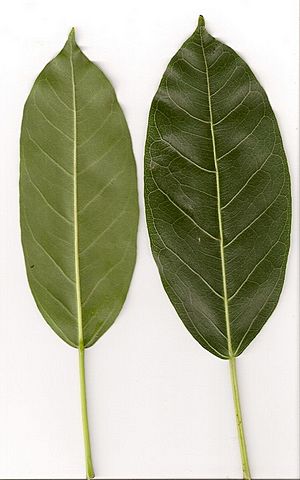Ficus virens var. sublanceolata facts for kids
Quick facts for kids Ficus virens var. sublanceolata |
|
|---|---|
 |
|
| Sub-lanceolate leaves | |
| Scientific classification |
|
| Kingdom: | Plantae |
| Clade: | Tracheophytes |
| Clade: | Angiosperms |
| Clade: | Eudicots |
| Clade: | Rosids |
| Order: | Rosales |
| Family: | Moraceae |
| Genus: | Ficus |
| Species: | |
| Varietas: |
F. v. var. sublanceolata
|
| Trinomial name | |
| Ficus virens var. sublanceolata (Miq.) Corner
|
|
| Synonyms | |
|
|
Ficus virens var. sublanceolata is a type of banyan tree, also known as a strangler fig. It often grows near the white fig tree. This tree has narrower leaves, shaped a bit like a spearhead. In Australia, people call it the white fig, sour fig, deciduous fig, or banyan. You can see a very big one north of Murwillumbah in New South Wales, near the Queensland border.
Contents
Where This Fig Tree Lives
This fig tree grows in many places. You can find it as far south as the Clarence River in New South Wales. It also grows across Queensland, the Torres Strait, the Northern Territory, and Western Australia. You can even find it in parts of South East Asia. It likes to grow in rich soil near rivers in rainforests.
What the Tree Looks Like
This is a very large tree. It can grow taller than 30 metres (about 100 feet). Its trunk can be wider than 1.8 metres (about 6 feet) across. Sometimes, it loses its leaves, so it's called "semi-deciduous." The base of the tree has strong, wide supports called buttresses. The bark is smooth and grey. It has small bumps and marks on the trunk. The small branches are smooth, but they have scars where old leaves used to be.
Its Leaves
The leaves grow one after another along the stem. They are usually 5 to 20 cm long and 2.5 to 6 cm wide. They are shaped like an oval spearhead. This is different from the white fig, which has wider leaves. The leaves are thin and shiny green on top. They are a duller, paler green underneath. Each leaf has a short, noticeable tip that often curls to one side. The base of the leaf is a bit rounded. The leaf stalks are narrow and long, about 2 to 5 cm in length.
Leaf Veins
The veins on the leaves are easy to see. They stick out on both sides of the leaf. The network of smaller veins near the leaf edge looks very pretty. There are 8 to 10 main side veins. They are creamy green and branch off the middle vein at about a 60-degree angle.
How This Fig Tree Reproduces
The flowers of this fig tree grow inside a special structure called a syconium, which is the fig itself. Tiny fig wasps pollinate the flowers while they are inside the fig. When the fig is ready, it changes color to white, pinkish, or brown with red spots. It is about 10 mm wide and grows almost directly on the stem. In Australia, the fruit is usually ripe from June to August, but you can find ripe figs at other times too.
Many different birds eat these figs. Some of them include the Australasian figbird, green catbird, Lewin's honeyeater, topknot pigeon, and pied currawong. New trees can grow from fresh seeds or from cuttings. A special way to grow new trees, called "marcotting," works well for Ficus virens var. sublanceolata.
Uses for the Tree
This tree is great for planting in parks and large gardens. It makes a beautiful ornamental tree. You can often see it planted in Australian parks and botanic gardens. However, the wood from this tree is not used for commercial purposes like building or furniture.

